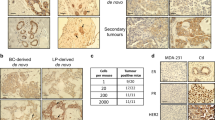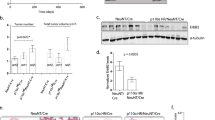Abstract
Expression of c-Myc is highly prevalent in human breast cancer and stability of the oncoprotein is regulated through Ras-regulated phosphorylation at serine 62 and threonine 58. Previous studies have illustrated the importance of accumulation of KRas mutations in Myc-mediated tumor formation. To examine Myc dependence upon Ras mutations we have generated MMTV regulated Myc and Myc T58A transgenic mice. Expression of the more stable T58A Myc allele resulted in a reduction in KRas-activating mutations. However, in a low-level expression T58A Myc transgenic, the majority of the tumors were squamous or epithelial-to-mesenchymal in nature and accumulated KRas mutations at a higher frequency. Interestingly, we show that these mice develop similar gene expression patterns and signaling pathway utilization as a subtype of human claudin-low breast cancer. Indeed, our results demonstrate a clear division in human claudin-low tumors based on Myc pathway activation and target genes. Together, our results demonstrate that Myc expression and stability has critical effects on molecular heterogeneity in mouse mammary tumors that parallel subtypes of human breast cancer.
This is a preview of subscription content, access via your institution
Access options
Subscribe to this journal
Receive 50 print issues and online access
$259.00 per year
only $5.18 per issue
Buy this article
- Purchase on Springer Link
- Instant access to full article PDF
Prices may be subject to local taxes which are calculated during checkout






Similar content being viewed by others
References
Perou CM, Sorlie T, Eisen MB, van de Rijn M, Jeffrey SS, Rees CA et al. Molecular portraits of human breast tumours. Nature 2000; 406: 747–752.
Sorlie T, Perou CM, Tibshirani R, Aas T, Geisler S, Johnsen H et al. Gene expression patterns of breast carcinomas distinguish tumor subclasses with clinical implications. Proc Natl Acad Sci USA 2001; 98: 10869–10874.
Sorlie T, Tibshirani R, Parker J, Hastie T, Marron JS, Nobel A et al. Repeated observation of breast tumor subtypes in independent gene expression data sets. Proc Natl Acad Sci USA 2003; 100: 8418–8423.
Prat A, Parker JS, Karginova O, Fan C, Livasy C, Herschkowitz JI et al. Phenotypic and molecular characterization of the claudin-low intrinsic subtype of breast cancer. Breast Cancer Res 2010; 12: R68.
Sotiriou C, Neo SY, McShane LM, Korn EL, Long PM, Jazaeri A et al. Breast cancer classification and prognosis based on gene expression profiles from a population-based study. Proc Natl Acad Sci USA 2003; 100: 10393–10398.
Deming SL, Nass SJ, Dickson RB, Trock BJ . C-myc amplification in breast cancer: a meta-analysis of its occurrence and prognostic relevance. Br J Cancer 2000; 83: 1688–1695.
Blancato J, Singh B, Liu A, Liao DJ, Dickson RB . Correlation of amplification and overexpression of the c-myc oncogene in high-grade breast cancer: FISH, in situ hybridisation and immunohistochemical analyses. Br J Cancer 2004; 90: 1612–1619.
Andrechek ER, Nevins JR . Mouse models of cancers: opportunities to address heterogeneity of human cancer and evaluate therapeutic strategies. J Mol Med 2010; 88: 1095–1100.
Gatza ML, Lucas JE, Barry WT, Kim JW, Wang Q, Crawford MD et al. A pathway-based classification of human breast cancer. Proc Natl Acad Sci USA 2010; 107: 6994–6999.
Nesbit CE, Tersak JM, Prochownik EV . MYC oncogenes and human neoplastic disease. Oncogene 1999; 18: 3004–3016.
Chrzan P, Skokowski J, Karmolinski A, Pawelczyk T . Amplification of c-myc gene and overexpression of c-Myc protein in breast cancer and adjacent non-neoplastic tissue. Clin Biochem 2001; 34: 557–562.
Sears R, Leone G, DeGregori J, Nevins JR . Ras enhances Myc protein stability. Mol Cell 1999; 3: 169–179.
Sears R, Nuckolls F, Haura E, Taya Y, Tamai K, Nevins JR . Multiple Ras-dependent phosphorylation pathways regulate Myc protein stability. Genes Dev 2000; 14: 2501–2514.
Amati B, Dalton S, Brooks MW, Littlewood TD, Evan GI, Land H . Transcriptional activation by the human c-Myc oncoprotein in yeast requires interaction with Max. Nature 1992; 359: 423–426.
Kim J, Woo AJ, Chu J, Snow JW, Fujiwara Y, Kim CG et al. A Myc network accounts for similarities between embryonic stem and cancer cell transcription programs. Cell 2010; 143: 313–324.
Stewart TA, Pattengale PK, Leder P . Spontaneous mammary adenocarcinomas in transgenic mice that carry and express MTV/myc fusion genes. Cell 1984; 38: 627–637.
Sinn E, Muller W, Pattengale P, Tepler I, Wallace R, Leder P . Coexpression of MMTV/v-Ha-ras and MMTV/c-myc genes in transgenic mice: synergistic action of oncogenes in vivo. Cell 1987; 49: 465–475.
D’Cruz CM, Gunther EJ, Boxer RB, Hartman JL, Sintasath L, Moody SE et al. c-MYC induces mammary tumorigenesis by means of a preferred pathway involving spontaneous Kras2 mutations. Nat Med 2001; 7: 235–239.
Podsypanina K, Politi K, Beverly LJ, Varmus HE . Oncogene cooperation in tumor maintenance and tumor recurrence in mouse mammary tumors induced by Myc and mutant Kras. Proc Natl Acad Sci USA 2008; 105: 5242–5247.
Wang X, Cunningham M, Zhang X, Tokarz S, Laraway B, Troxell M et al. Phosphorylation regulates c-Myc’s oncogenic activity in the mammary gland. Cancer Res 2011; 71: 925–936.
Andrechek ER, Cardiff RD, Chang JT, Gatza ML, Acharya CR, Potti A et al. Genetic heterogeneity of Myc-induced mammary tumors reflecting diverse phenotypes including metastatic potential. Proc Natl Acad Sci USA 2009; 106: 16387–16392.
Tusher VG, Tibshirani R, Chu G . Significance analysis of microarrays applied to the ionizing radiation response. Proc Natl Acad Sci USA 2001; 98: 5116–5121.
Bild AH, Yao G, Chang JT, Wang Q, Potti A, Chasse D et al. Oncogenic pathway signatures in human cancers as a guide to targeted therapies. Nature 2006; 439: 353–357.
Herschkowitz JI, Zhao W, Zhang M, Usary J, Murrow G, Edwards D et al. Breast cancer special feature: comparative oncogenomics identifies breast tumors enriched in functional tumor-initiating cells. Proc Natl Acad Sci USA 2011; 109: 2778–2783.
Lim E, Wu D, Pal B, Bouras T, Asselin-Labat ML, Vaillant F et al. Transcriptome analyses of mouse and human mammary cell subpopulations reveal multiple conserved genes and pathways. Breast Cancer Res 2010; 12: R21.
Singh A, Greninger P, Rhodes D, Koopman L, Violette S, Bardeesy N et al. A gene expression signature associated with ‘K-Ras addiction’ reveals regulators of EMT and tumor cell survival. Cancer Cell 2009; 15: 489–500.
McCormack SJ, Weaver Z, Deming S, Natarajan G, Torri J, Johnson MD et al. Myc/p53 interactions in transgenic mouse mammary development, tumorigenesis and chromosomal instability. Oncogene 1998; 16: 2755–2766.
Herschkowitz JI, Simin K, Weigman VJ, Mikaelian I, Usary J, Hu Z et al. Identification of conserved gene expression features between murine mammary carcinoma models and human breast tumors. Genome Biol 2007; 8: R76.
Carvalho CM, Chang J, Lucas JE, Nevins JR, Wang Q, West M . High-dimensional sparse factor modeling: applications in gene expression genomics. J Am Stat Assoc 2008; 103: 1438–1456.
Andrechek ER, Mori S, Rempel RE, Chang JT, Nevins JR . Patterns of cell signaling pathway activation that characterize mammary development. Development 2008; 135: 2403–2413.
Acknowledgements
A portion of this project was funded by a grant from the Elsa U Pardee foundation to ERA.
Author information
Authors and Affiliations
Corresponding author
Ethics declarations
Competing interests
The authors declare no conflict of interest.
Additional information
Supplementary Information accompanies the paper on the Oncogene website
Supplementary information
Rights and permissions
About this article
Cite this article
Hollern, D., Yuwanita, I. & Andrechek, E. A mouse model with T58A mutations in Myc reduces the dependence on KRas mutations and has similarities to claudin-low human breast cancer. Oncogene 32, 1296–1304 (2013). https://doi.org/10.1038/onc.2012.142
Received:
Revised:
Accepted:
Published:
Issue Date:
DOI: https://doi.org/10.1038/onc.2012.142
Keywords
This article is cited by
-
HAS3-induced extracellular vesicles from melanoma cells stimulate IHH mediated c-Myc upregulation via the hedgehog signaling pathway in target cells
Cellular and Molecular Life Sciences (2020)
-
E2F1 Drives Breast Cancer Metastasis by Regulating the Target Gene FGF13 and Altering Cell Migration
Scientific Reports (2019)
-
Effective personalized therapy for breast cancer based on predictions of cell signaling pathway activation from gene expression analysis
Oncogene (2017)
-
Clinical and molecular relevance of mutant-allele tumor heterogeneity in breast cancer
Breast Cancer Research and Treatment (2017)
-
Claudin proteins, outside-in signaling, and carcinogenesis
Pflügers Archiv - European Journal of Physiology (2017)



